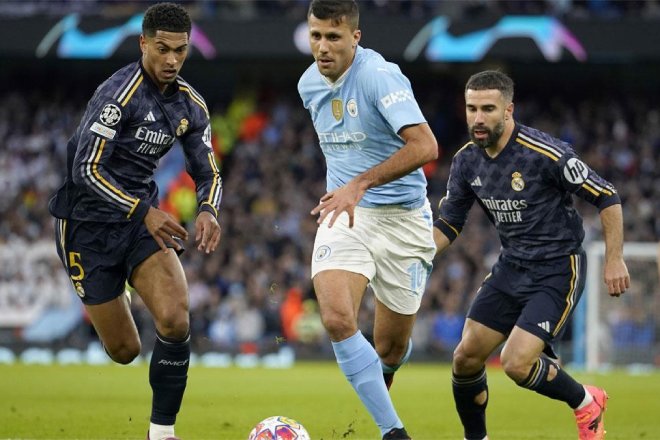A new force is in town and threatening the power of the Brazilian league to attract top Latin American football talent: Major League Soccer.
The North American MLS has already replaced Argentina and Mexico's top flights as the main challengers to Brazil's hegemony.
It is partly thanks to a change of strategy.
Rather than trying to attract attention by signing star names from European leagues looking for a pay day before retirement, the MLS is now competing for the young Latin American pearls that would otherwise head to Brazil en route to Europe.
It is a tactic that has not only improved the level of a league only founded in 1996, but also generates profits when the European teams come calling.
"It is part of the vision that team owners have had to convert (MLS) into one of the great world level leagues," Alfonso Mondelo, the MLS director of competitions, told AFP.
From begging to being called
Since 2021, MLS is the league that has spent the most on transfer fees in the Americas, according to analysis by AFP on transfer reports provided by world football's governing body FIFA.
In 2021, MLS spent $159.9 million on transfers: three times more than Brazil, five times more than Mexico and 11 times more than Argentina.
The next year, when the other three leagues were recovering from the pandemic, they still outspent the Argentine and Mexican leagues by more than two-to-one and the Brazilian league by 1.6-to-one.
Those numbers are still a far cry from the English Premier League, where clubs spent almost $900 million in the January transfer window alone.
"In the first years of the MLS, you almost had to beg the players to come, now they contact us," said Mondelo.
In February 2022, Atlanta United paid $16 million to Argentine club Velez Sarsfield for Thiago Almada.
"I want to have a good season and have the opportunity to go to Europe," he said at the time.
Ten months later, he became the first active MLS player to win the World Cup.
Almada, now 21, has been a sensation this year, scoring a clutch of stunning goals for his club and last week notched his first international goal in only his third appearance for the Albiceleste.
Before Almada, Atlanta bought Paraguayan Miguel Almiron from Argentines Lanus and sold him to Newcastle United three years later.
US to become top market
The new strategy is bearing fruit for the MLS, whose 29 teams' squads worth a combined $1.25 billion, second only in the region to the 20 Brazilian teams' squads, worth $1.45 billion, according to the specialized website Transfermarkt.
"The United States, in terms of market value, will end up in first place because they know how to do massive business. It's growing in the right way, gradually," said Brazilian football agent Marcelo Mascagni.
But its teams still have a lot of catching up to do on the pitch.
They have won the top CONCACAF competition just three times, compared to 37 for Mexican teams.
"It is important to first become the most important league in CONCACAF -- our next challenge -- and then see how we can get to the level of the best leagues in the world," said Mondelo.
Brazil still has what MLS is looking for: continental domination. Flamengo and Palmeiras have won the last four Copa Libertadores titles between them.
Despite its teams suffering financial difficulties, Brazil is a major production line of talented players, allowing clubs to build competitive squads.
They have also managed to attract stars in the twilight of their careers, such as Uruguay's Luis Suarez, Chile's Arturo Vidal and Brazil's Marcelo.
Brazilian teams also earn more in sales than anywhere else in the Americas.
In 2022, the Brazilian league sold 998 players for $267.2 million, almost as much as Argentina ($146.6 million) and MLS (135.2 million) combined, according to FIFA.
But that figure was 30 percent less than in 2018, despite selling 166 more players.
"Disorganization" is to blame, according to Mascagni, with Brazilian clubs failing to sell at the optimal time and European clubs poaching Brazilian talents at ever younger ages.
US the main focus
The problem for Argentine clubs is the same one affecting the whole country: scarcity of dollars, which are used in international transfers, the devaluation of the peso and high inflation.
Argentine teams spent 20 percent less on transfers in 2022 compared to 2018, bringing in 26 percent less in sales.
The young hopefuls they used to sign from other South American countries are now heading to Brazil and the MLS.
The Argentine league is ageing: an average of 26.7 years in 2022, compared to 24 in 2018.
"Argentina is not an attractive league, except for" River Plate and Boca Juniors, said transfer specialist Jaime Rascon.
"They have a currency devaluation that makes it difficult for any footballer to maintain his spending power and lifestyle."
Foreign clubs are also wary of selling players to Argentina after some issues with non payments.
"Doing business with the United States has become the main focus," said Ramiro Ruiz, president of Colombian team Envigado.
They sold Colombia international James Rodriguez to Argentina's Banfield in 2008, after which he moved on to Europe, eventually joining Real Madrid.
But Envigado sold their latest jewel, forward Jhon Jader Duran, to Chicago Fire, who then shipped him on to Aston Villa in January for almost $18 million.
Argentina does have one advantage, though, given it is the world's second largest exporter of players, with more than 1,000 currently playing in foreign leagues -- half the number of Brazilians abroad -- according to FIFA.
Argentine clubs do often sell top young players straight to major European clubs, such as Julian Alvarez's transfer to Manchester City from River Plate for a reported 21.4 million euros.
Historically, Mexican clubs could also spend massive transfer fees and offer attractive salaries. But not any more.
Over the last five years transfer spending dropped by more than a third and fees received by 50 percent.
























